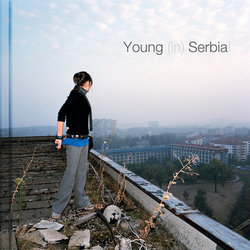YOUNG SERBIA
Hardcover linen book / 20×25 cm
80 Pag /Pan-F/ 2010
Project Dwelling and Belonging
While the bulk of the Western press corps has long since traded the Balkans for other hot spots, the post-war situation in the region creates possibilities as a field for documentary photography. Furthermore, the boundary between intriguing and stereotypical approaches is difficult to draw. In the Western imagination, the image of the Balkans is dominated by the cliché of rash bandits, wild gypsies and otherwise ill-mannered half-barbarians. In a certain sense the Balkans are a symbol for what we in Western Europe have gradually gotten rid of in our so-called civilisation process. Moreover, our image of Serbia is still further clouded because the country is regarded as the chief culprit in the Yugoslavian wars of the 1990s.
These wars are history now, but Serbia still has to live with their effects every day. For the young people of the capital, who grew up relatively far away from the real violence of the war, consequences are visible and tangible. In scarcely twenty years Serbia degenerated into a regressive society that has become accustomed to the certainty of uncertainty and the lack of any perspective on the future. This hopelessness is only intensified by the rigid visa policy of Western European countries –– a remnant of the years-long international isolation imposed on the country. It is against such a post-apocalyptic background that the young people are searching –– like others of their generation elsewhere in Europe –– for their own individuality and identity. Some reveal themselves in perverse alter egos who comb the city for smoky new wave fetish parties, while others place their hope in ultra-right ideals and in their asphalt jungle dream of a Greater Serbia restoration.
![Making a portrait of Tina]()
Belgrade is a hard, unpolished, but at the same time open city where anarchist freedom and the absence of constraint can be celebrated against the backdrop of an uncertain future. The atmosphere that Nozeman encountered, reminds of the Netherlands of the 1980s and ‘90s –– the heyday of a do-it-yourself mentality, the punk movement and later the illegal House Parties. Perhaps the introspective portraits by Mark Nozeman show us again something that we slowly have forgotten in Western Europe: unsponsored individuality, creative chaos and intensely experienced freedom.
De Stichting Sem Presser Archief heeft sinds 2000 projecten op het gebied van fotografie ondersteund. De financiële middelen kwamen uit de nalatenschap van Sem en Joke Presser. Ter afsluiting van haar activiteiten met het Sem Presser Fonds heeft de Stichting Sem Presser Archief een boek in 2015 laten produceren waarin ondersteunde projecten op een rij zijn gezet.
PAN-F © 2020 All rights reserved
80 Pag /Pan-F/ 2010
Project Dwelling and Belonging
While the bulk of the Western press corps has long since traded the Balkans for other hot spots, the post-war situation in the region creates possibilities as a field for documentary photography. Furthermore, the boundary between intriguing and stereotypical approaches is difficult to draw. In the Western imagination, the image of the Balkans is dominated by the cliché of rash bandits, wild gypsies and otherwise ill-mannered half-barbarians. In a certain sense the Balkans are a symbol for what we in Western Europe have gradually gotten rid of in our so-called civilisation process. Moreover, our image of Serbia is still further clouded because the country is regarded as the chief culprit in the Yugoslavian wars of the 1990s.
These wars are history now, but Serbia still has to live with their effects every day. For the young people of the capital, who grew up relatively far away from the real violence of the war, consequences are visible and tangible. In scarcely twenty years Serbia degenerated into a regressive society that has become accustomed to the certainty of uncertainty and the lack of any perspective on the future. This hopelessness is only intensified by the rigid visa policy of Western European countries –– a remnant of the years-long international isolation imposed on the country. It is against such a post-apocalyptic background that the young people are searching –– like others of their generation elsewhere in Europe –– for their own individuality and identity. Some reveal themselves in perverse alter egos who comb the city for smoky new wave fetish parties, while others place their hope in ultra-right ideals and in their asphalt jungle dream of a Greater Serbia restoration.
Belgrade is a hard, unpolished, but at the same time open city where anarchist freedom and the absence of constraint can be celebrated against the backdrop of an uncertain future. The atmosphere that Nozeman encountered, reminds of the Netherlands of the 1980s and ‘90s –– the heyday of a do-it-yourself mentality, the punk movement and later the illegal House Parties. Perhaps the introspective portraits by Mark Nozeman show us again something that we slowly have forgotten in Western Europe: unsponsored individuality, creative chaos and intensely experienced freedom.
De Stichting Sem Presser Archief heeft sinds 2000 projecten op het gebied van fotografie ondersteund. De financiële middelen kwamen uit de nalatenschap van Sem en Joke Presser. Ter afsluiting van haar activiteiten met het Sem Presser Fonds heeft de Stichting Sem Presser Archief een boek in 2015 laten produceren waarin ondersteunde projecten op een rij zijn gezet.
PAN-F © 2020 All rights reserved




